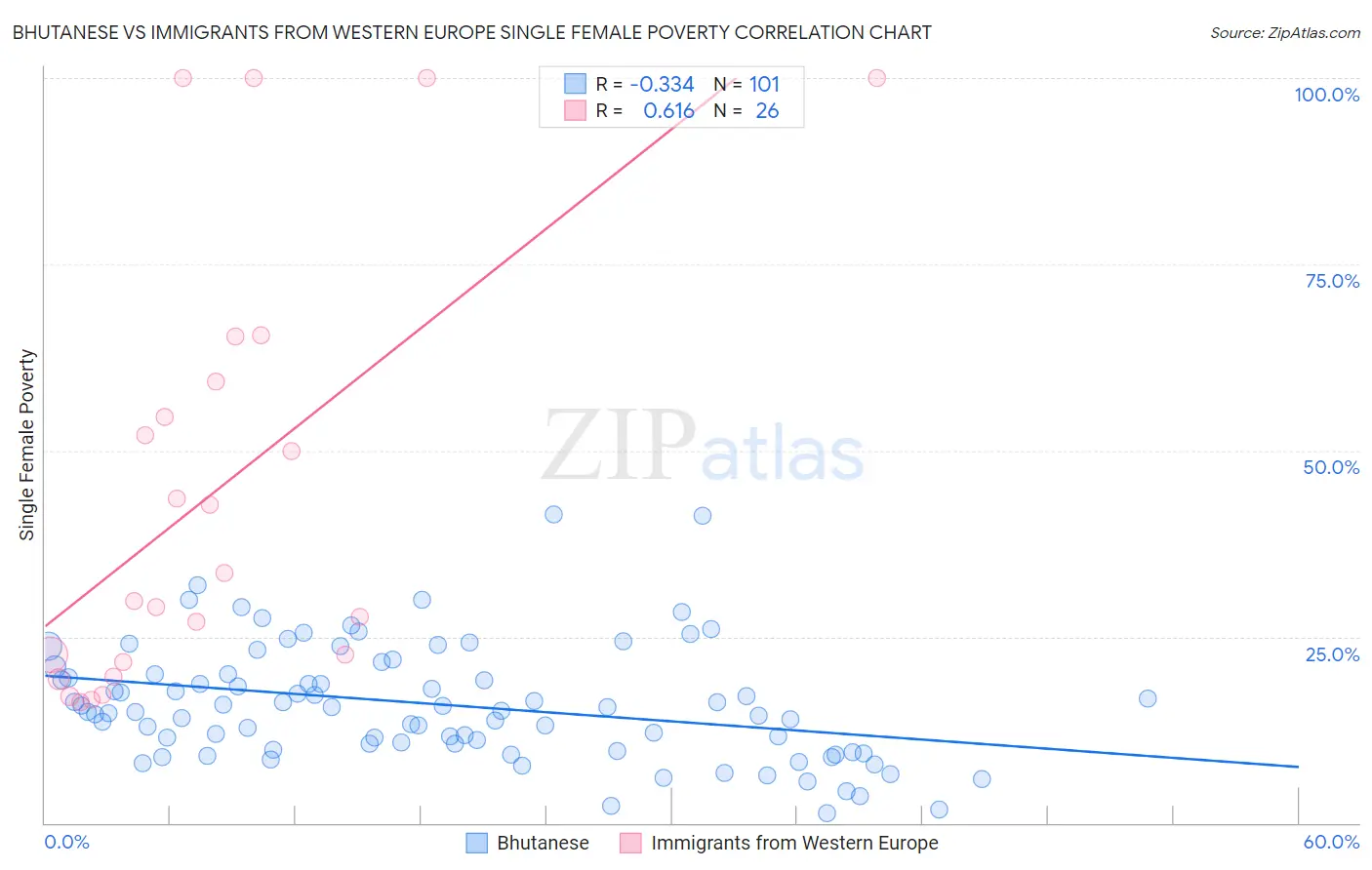Bhutanese vs Immigrants from Western Europe Single Female Poverty
COMPARE
Bhutanese
Immigrants from Western Europe
Single Female Poverty
Single Female Poverty Comparison
Bhutanese
Immigrants from Western Europe
17.7%
SINGLE FEMALE POVERTY
100.0/ 100
METRIC RATING
9th/ 347
METRIC RANK
20.6%
SINGLE FEMALE POVERTY
76.7/ 100
METRIC RATING
154th/ 347
METRIC RANK
Bhutanese vs Immigrants from Western Europe Single Female Poverty Correlation Chart
The statistical analysis conducted on geographies consisting of 446,564,428 people shows a mild negative correlation between the proportion of Bhutanese and poverty level among single females in the United States with a correlation coefficient (R) of -0.334 and weighted average of 17.7%. Similarly, the statistical analysis conducted on geographies consisting of 482,241,585 people shows a significant positive correlation between the proportion of Immigrants from Western Europe and poverty level among single females in the United States with a correlation coefficient (R) of 0.616 and weighted average of 20.6%, a difference of 16.5%.

Single Female Poverty Correlation Summary
| Measurement | Bhutanese | Immigrants from Western Europe |
| Minimum | 1.3% | 16.2% |
| Maximum | 41.4% | 100.0% |
| Range | 40.1% | 83.8% |
| Mean | 15.9% | 44.3% |
| Median | 15.1% | 31.6% |
| Interquartile 25% (IQ1) | 10.2% | 21.6% |
| Interquartile 75% (IQ3) | 19.9% | 59.2% |
| Interquartile Range (IQR) | 9.7% | 37.6% |
| Standard Deviation (Sample) | 7.8% | 28.7% |
| Standard Deviation (Population) | 7.8% | 28.2% |
Similar Demographics by Single Female Poverty
Demographics Similar to Bhutanese by Single Female Poverty
In terms of single female poverty, the demographic groups most similar to Bhutanese are Immigrants from Ireland (17.8%, a difference of 0.41%), Immigrants from Lithuania (17.8%, a difference of 0.50%), Immigrants from South Central Asia (17.8%, a difference of 0.56%), Immigrants from Bolivia (17.8%, a difference of 0.82%), and Bolivian (17.9%, a difference of 1.3%).
| Demographics | Rating | Rank | Single Female Poverty |
| Immigrants | Taiwan | 100.0 /100 | #2 | Exceptional 16.4% |
| Immigrants | Hong Kong | 100.0 /100 | #3 | Exceptional 16.5% |
| Immigrants | India | 100.0 /100 | #4 | Exceptional 16.8% |
| Assyrians/Chaldeans/Syriacs | 100.0 /100 | #5 | Exceptional 17.0% |
| Filipinos | 100.0 /100 | #6 | Exceptional 17.0% |
| Thais | 100.0 /100 | #7 | Exceptional 17.3% |
| Immigrants | Iran | 100.0 /100 | #8 | Exceptional 17.5% |
| Bhutanese | 100.0 /100 | #9 | Exceptional 17.7% |
| Immigrants | Ireland | 100.0 /100 | #10 | Exceptional 17.8% |
| Immigrants | Lithuania | 100.0 /100 | #11 | Exceptional 17.8% |
| Immigrants | South Central Asia | 100.0 /100 | #12 | Exceptional 17.8% |
| Immigrants | Bolivia | 100.0 /100 | #13 | Exceptional 17.8% |
| Bolivians | 100.0 /100 | #14 | Exceptional 17.9% |
| Indians (Asian) | 100.0 /100 | #15 | Exceptional 17.9% |
| Iranians | 100.0 /100 | #16 | Exceptional 18.0% |
Demographics Similar to Immigrants from Western Europe by Single Female Poverty
In terms of single female poverty, the demographic groups most similar to Immigrants from Western Europe are Swedish (20.6%, a difference of 0.030%), Samoan (20.6%, a difference of 0.060%), Immigrants from Uruguay (20.6%, a difference of 0.080%), South American Indian (20.6%, a difference of 0.10%), and Immigrants from Oceania (20.7%, a difference of 0.21%).
| Demographics | Rating | Rank | Single Female Poverty |
| South Africans | 85.3 /100 | #147 | Excellent 20.4% |
| Luxembourgers | 84.9 /100 | #148 | Excellent 20.4% |
| Portuguese | 81.5 /100 | #149 | Excellent 20.5% |
| Immigrants | Denmark | 80.5 /100 | #150 | Excellent 20.5% |
| Puget Sound Salish | 79.6 /100 | #151 | Good 20.6% |
| Immigrants | Uruguay | 77.7 /100 | #152 | Good 20.6% |
| Swedes | 77.1 /100 | #153 | Good 20.6% |
| Immigrants | Western Europe | 76.7 /100 | #154 | Good 20.6% |
| Samoans | 76.0 /100 | #155 | Good 20.6% |
| South American Indians | 75.7 /100 | #156 | Good 20.6% |
| Immigrants | Oceania | 74.3 /100 | #157 | Good 20.7% |
| Danes | 73.0 /100 | #158 | Good 20.7% |
| Costa Ricans | 71.8 /100 | #159 | Good 20.7% |
| Arabs | 70.8 /100 | #160 | Good 20.7% |
| Kenyans | 68.5 /100 | #161 | Good 20.8% |